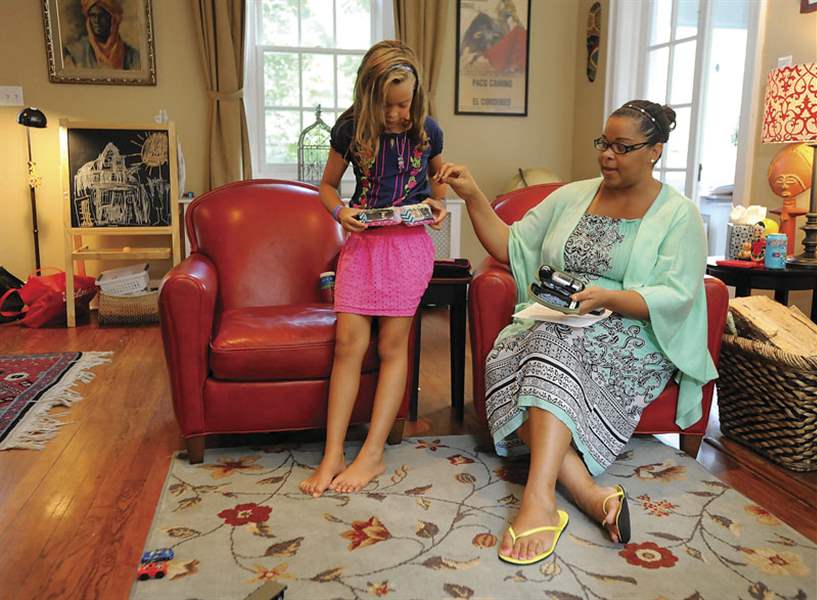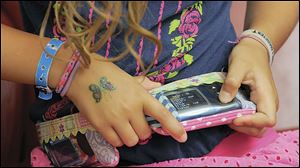
‘Bionic pancreas’ opens up new possibilities to kids with Type 1 diabetes
10/6/2014
Suzanne Razaq, right, checks her daughter Zara Cheek's insulin pump and glucose meter.
Baltimore Sun

Suzanne Razaq, right, checks her daughter Zara Cheek's insulin pump and glucose meter.
BALTIMORE — As 7-year-old Zara Cheek packed her bags for her first sleep-away camp this summer, she found herself looking forward to more than just swimming, going on hikes and eating S’mores for two glorious weeks.
To her, the experience meant a chance to live like a normal kid for a while — and even, quite possibly, to help thousands of others afflicted with the illness that has shaped her life.
Zara, who lives in West Baltimore and started third grade this fall, is one of about 2 million Americans who suffer from Type 1 diabetes, a chronic and potentially lethal disorder of the pancreas that leaves the body unable to make insulin or turn blood sugar into the energy it needs.
Though its causes are unknown, the implications of Type 1 diabetes are well established. Most who have it experience an acute onset, usually before age 30. Symptoms generally include weight loss, increased thirst and a need to urinate frequently. Sufferers must be given artificial insulin.
If left insufficiently treated, Type 1 diabetes can spark dangerous spikes or drops in blood-sugar level and, in the long term, complications as dire as heart failure and stroke.
Unlike Type 2 diabetes, which affects about 27 million Americans and can often be treated purely by diet and exercise, Type 1 diabetes is one of the world’s most taxing chronic illnesses to manage.
Diagnosed at age 2, in 2008, Zara — an avid reader with a shock of sun-kindled blond hair — has rarely been separated from the glucose sensor, digital monitor and electronic insulin pump she wears on her belt. Nor have her parents, Daniel Cheek and Suzanne Razaq, been free of the responsibility of monitoring that equipment 24 hours a day and adjusting it as a blizzard of factors evolve, from the amount of exercise Zara plans to take to the amount of stress she’s feeling.
“It’s an incredibly intense disease to handle, and unfortunately, it’s one that never lets up,” said Dr. Robert Ratner, chief scientific and medical officer of the American Diabetes Association.
This summer, Zara and her family finally got a chance to take a break.
Razaq, a real estate agent, was surfing the Internet late one night in July when she happened on a website that caught her eye. A Boston University biomedical engineer had spent years developing a system with all the functions of Zara’s equipment that, in effect, ran itself.

Zara Cheek, 7, looks at her insulin pump that's encased in a homemade belt.
It had performed well in real-world settings, she read, and the engineer, Ed Damiano, was looking for child volunteers to test it in clinical trials at a summer camp in August.
Called a “bionic pancreas,” it included a glucose sensor, a display monitor and a pump that delivered insulin. What made it different was that Damiano had added a “brain” to the system.
Where caregivers must watch a patient’s levels, assess the changing conditions of a given day, estimate each dosage size and program the pump to deliver it, Damiano and his team had developed a mathematical algorithm by which a smartphone-sized computer could assess those changing factors, make every calculation on its own, then dispense the appropriate dose, all without the conscious intervention of the patient or caregiver.
Various researchers have been working on developing an artificial pancreas for years, Ratner said. Such a device, he added, ideally will function like “the pancreas Mother Nature made,” measuring the body’s needs, “squirting” insulin in just the right amount, then shutting off to prevent overdose. About 20 groups around the world are working on such a project.
While Damiano is still in the process of seeking FDA approval, Razaq said she learned his device is approaching that ideal. It still consists of three separate units, not one, but they’re about the size of the ones Zara already wears. It also takes glucose readings 288 times a day, tailors the dosage size each time, and delivers it, whether the patient is sleeping, going to class, or dribbling a basketball.
The device does nothing to advance a cure — researchers say that outcome could be decades away — but it has the potential, Razaq said, to free sufferers and caregivers alike from having to think about Type 1 diabetes care every waking moment.
The previous summer, she learned, Damiano and fellow researchers, including a medical team from Massachusetts General Hospital, had run a two-week camp for adolescent Type 1 diabetes sufferers at Camp Clara Barton, a retreat and diabetes research center in Oxford, Mass. Attendees wore the device during normal camp activities.
The trial data suggested that the bionic pancreas keeps glucose levels significantly more stable than other available methods.
“The results were good — much, much better than even we anticipated — and the kids seemed to have a great time,” said Damiano, whose paper on the project was published in the New England Journal of Medicine in June.
Razaq sent Damiano an email to see if Zara could attend the next camp. She knew it was a long shot, as there was a sizable waiting list, but Zara happened to be one of the few 7-year-old applicants who fit the necessary medical profile and were willing to be away from home for two weeks. Within days, she was packing.
For 14 days in August, she lived like any other kid at camp — sleeping in tents, downing hot dogs, playing soccer — as the device did its work.
It was a time, she said, when she and the 11 other girls in the study didn’t have to count carbs, adjust dosing, or make any preparations before exercise.
No matter the stress she put on it, she said, the bionic pancreas made the necessary adjustments.
“I had an excellent time, and I never got homesick,” she recalled in her living room, flashing a multicolored headband and bracelets she made at camp. “I can’t wait to go next year.”
Damiano, whose son, David, has Type 1 diabetes, has vowed to get the device to market by the time the young man goes off to college in 2017. He believes they’ll make the deadline.
Razaq is certainly hopeful. It wasn’t easy to let her daughter, now 8, go for two weeks, she said, but it was worth it.
“If [the bionic pancreas] comes to market, Zara may be one of the early recipients,” she said. “If it becomes the standard of care, she will have helped make history. But even if it doesn’t make it to market, Zara [has] experienced what it feels like to be a kid without diabetes.”